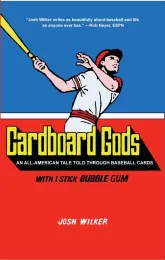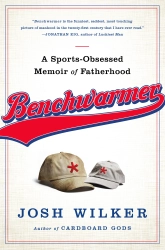Born in the USA
(continued from Al Bumbry)
Chapter Four
I.
Baseball came to a halt for a while. Xeroxed fliers with pictures of the missing blossomed on walls all over the city. Obituaries began appearing in the newspaper. Eventually the fliers withered, feeding the next bloom, the glittering fungal explosion of flags.
A metal flag pin the size of a thumbnail came into my possession. I don’t remember how. They were everywhere, these flags. Baseball returned, festooned in flags. In the seventh inning everyone in attendance now rose to sing “God Bless America.” I wasn’t sleeping much. “Last night there was a loud noise that woke me,” I wrote in my journal on September 18. “I guess it was a slow-moving tractor trailer, but at first, coming out of sleep, all I could think was bomb, shockwave, death on the way.” I’d never before worn a pin of any kind, but right around then I started wearing the little metal flag on the heart-side pocket of my jacket.
II.
Baseball and war have almost always marched in lockstep. According to Hall of Fame baseball pioneer Albert Spalding, who learned the game from veterans returning from the Civil War, baseball took root as America’s national game during “the bloody days of our Nation’s direst danger . . . when soldiers, North and South, [strove] to forget their foes by cultivating, through this grand game, fraternal friendship with comrades in arms.” During World War I major league teams spent part of each day performing military drills, and several players went into the armed forces, including two of the greatest pitchers of all time, Christy Mathewson and Grover Cleveland Alexander, who both sustained serious injuries during the war. In World War II, major league rosters emptied of anyone determined to be physically able to serve, some of the players spending the war on morale-boosting service baseball teams while others, such as eventual Hall of Famers Bob Feller and Hank Greenberg, won medals for their service and bravery during combat.
The man shown in the 1977 card above enlisted in the Marines in the early 1960s, before his ability to throw a baseball had gained widespread renown. His time in the service predated heavy U.S. involvement in Vietnam. After the Marines he pitched for Fresno City College, then for the Alaska Goldpanners, then for the University of Southern California. By the year I was born, that bloody divisive year of 1968, Tom Seaver had established himself as one of the best young pitchers in all of baseball.
III.
I don’t remember much about the lead-up to the U.S. invasion of Afghanistan. I just checked my journal from that time and found that I stopped writing about life as I was living it, instead making attempts to disappear into the creation of a fictional world based on my life as a child in the 1970s. I remember wondering if the fiction I was writing had any worth at all. This doubt went beyond my usual doubt about my work, went beyond questions of whether it was good enough. I could look out my window in Williamsburg and see the black smoke rising across the river. How could my stupid little story speak to that?
“I have to go to work now,” I wrote in my journal on September 19, abandoning that day’s stab at fiction to speak directly about the world around me for what would be the last time for a long time. “The rubble at the World Trade Center is still smoking. The corpses and pieces of corpses must be charred, black, ashes. I work at a book store. The book store will be closing soon. . . . Nothing is certain. This is why I’m writing about the people I love and the life I’ve seen.”
That’s what I told myself anyway. But I think in retrospect it was also a question of trying to find a safe haven. In some ways it was the strangest fiction project I’d ever undertaken, because what I ended up doing was trying to rewrite from scratch a story that I’d already written several years before, the first short story I’d ever been at least temporarily happy with. It was a story about my brother and me visiting my father in New York City during the blackout of 1977. I’d written it in the early 1990s, and then in the fall of 2001 I wrote it again, going to the notebook each day to disappear into the citywide calamity that had never felt dangerous. It had felt, on the contrary, as if we were part of an us, connected to the rest of the people in the city, and more than that it had felt as if the three of us, my brother, my father, and me, were connected as never before. We were all in it together. We were safe.
IV.
Imperfections feed perfection. Take the slight imbalance of the card at the top of this page, the right border thinner than the left. This imperfection feeds the impression of coiled energy created by the photo of the pitcher in mid-windup. The lopsided bordering makes it seem the whole world is one slim moment away from catapulting with perfect graceful ferocity forward. Or take the dirt on the knee, the only smudge on the otherwise immaculate uniform. This imperfection further foreshadows the likely perfection of the pitch, Seaver famous for getting his body so low while unleashing his blazing offerings that his right knee scraped the ground. Or take the dulled corners of the card. This imperfection speaks of the card as an active part of a boy’s life, a much-used talisman, and it speaks also of the back of the card, of fingers constantly turning the card from one side to the other, from photo of perfect crackling poise to table of perfect statistics.
And on the back the only imperfection is one that comes from the overlay of history. Looking at the back of the card, seeing the unbroken string of years with one team, no team in baseball history ever as associated with a single player as much as the Mets and Tom Seaver, there is the knowledge that Tom Seaver will soon be traded. It will happen in the middle of this very season, just a month before the blackout, the back-of-the-card perfection forever marred. But it hasn’t happened yet. On this card there is only one season after another of excellence. The brief line of text below the statistics highlights the most perfect of all the columns: “Tom extended his all-time mark in 1976 by topping 200 K’s 9th straight season.”
He’d been striking out 200 men every year that I’d been alive. In 1977, the year I would later try to escape to as an adult, I looked at this card and followed the perfect line of 200s up and back through the years, each year festooned with other spectacular numbers, stellar ERAs, admirable won-loss records. But none were better than his second year, 1969, the year Tom Seaver and the team he will forever be associated with blossomed into the miraculous.
V.
We went to war. I had my flag pin on. I’d never supported a war before, had never really seen the reasons behind the various U.S. hostilities in my adult lifetime. But if I remember correctly my feelings as we moved toward an invasion of Afghanistan were that we were an Us who had been attacked by a Them, a Them that wanted anyone born in the USA dead, and the Them was hiding in caves in Afghanistan. The newspapers I read kept bringing me pictures of the dead. Could have been a loved one. Could have been me. It scared and angered me. Go ahead, I thought. Blow them and their infantile virgin-glutted paradise to dust.
VI.
“If the Mets can win the World Series, the United States can get out of Vietnam.” – Tom Seaver, 1969
On October 15, 1969, protesters in cities all across the country staged the largest antiwar protest in the history of the United States. That same day, Tom Seaver took the mound at Shea Stadium in Game 4 of the World Series against a mighty Baltimore Orioles team. An Oriole win would even the series and ensure that it return to Baltimore. Seaver gutted out a 10-inning 2-1 win, putting the Mets on the brink of perhaps the most improbable World Series championship in the history of baseball.
A month later, my mother went to a peace march in Washington, D.C., that topped the October march for participation and impact. The message was starting to get across. The Nixon administration had already begun trying to portray antiwar protesters as dangerous radicals, but it was beginning to be clear that it was more than that. Many Americans were starting to wonder why we had gotten so deep into a war that didn’t seem to make any sense. Housewives from New Jersey were wondering. Tom Seaver was wondering. As far as I can tell, it was the first time the U.S. pastime of baseball ever stepped out of cadence with the U.S. pastime of war.
VII.
I tried to go to an antiwar rally, my first, as the Bush administration pushed the United States into a war against Iraq. I’d stopped wearing my little flag pin by then. I’d grown weary of the seventh inning singing of “God Bless America.” Or maybe wary is a better word than weary. Now the flags and the song seemed less a way of asserting that We were a We and more a way of stomping out any dissenting opinions while bulldozing toward a new era of war. An invasion of Iraq didn’t seem to make any sense except as a way for rich oilmen to grab oil fields. The people who had attacked us didn’t have any connection with Iraq.
I went to the rally with my mom but we got separated in the crowd somehow. There were cops everywhere and the protesters had been shuttled into a relatively tiny area. The rationale for the treatment of protesters as if they were dangerous had been that it was for “security.” There was a menacing feel to the day. Cops in riot helmets, gripping nightsticks, younger protesters getting impatient, knocking over the blue barriers that had turned the city into an asphyxiating maze. I got out of there before hearing any speeches. Fuck it. The war began anyway. Baseball continued. The war continued. I dissolved into one, tried to ignore the other. God bless America. Land that I love.
“On the ground were two blood-soaked Iraqi men,” former Iraq War combatant John Crawford writes in his 2005 book The Last True Story I’ll Ever Tell. “Both were on their faces with their hands tied behind their backs. The skinnier one was crying, and with the nudge of the foot someone tried to shut him up. ‘There’s no crying in baseball.’
“We all giggled a little at that.”






